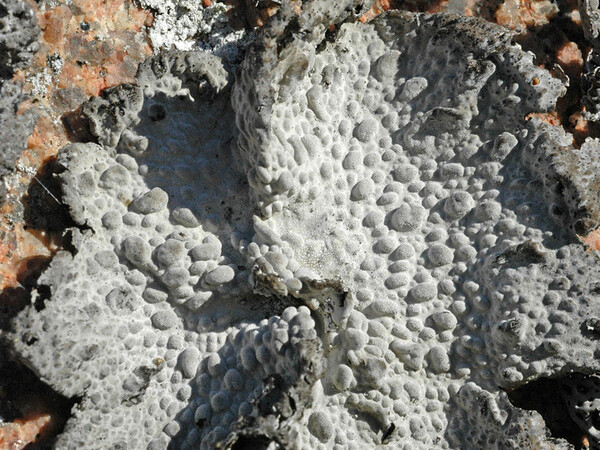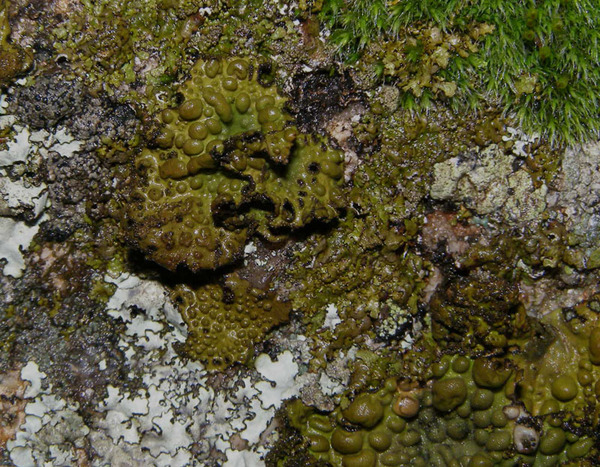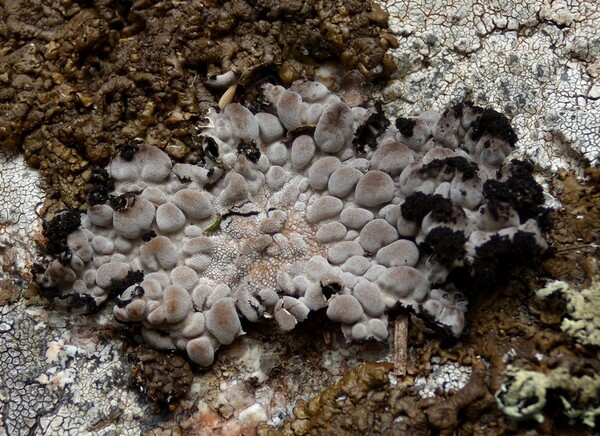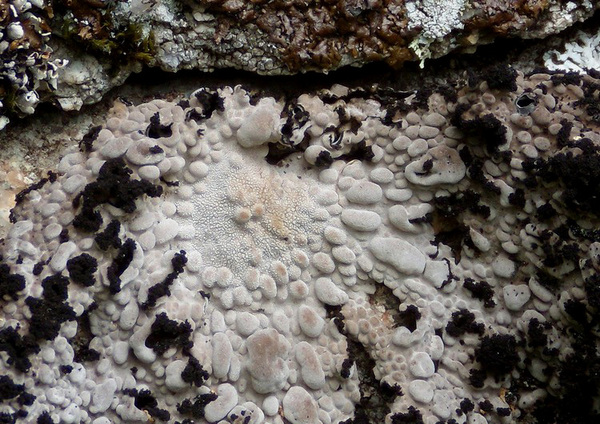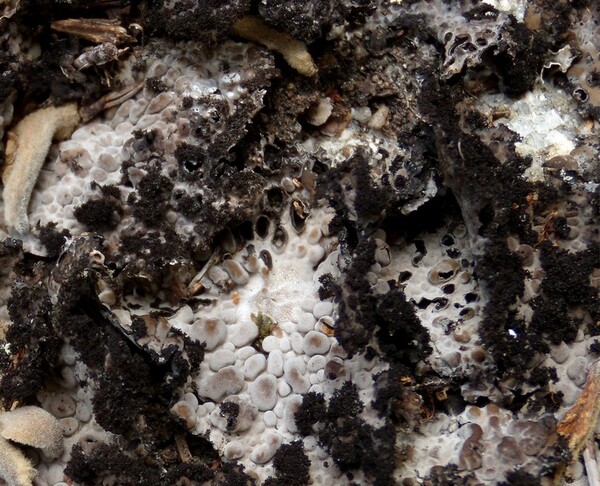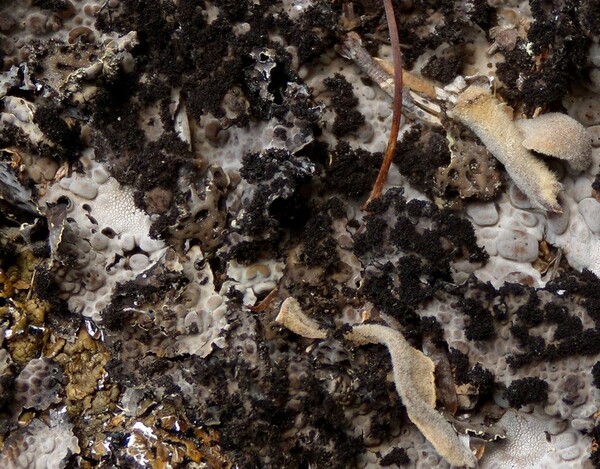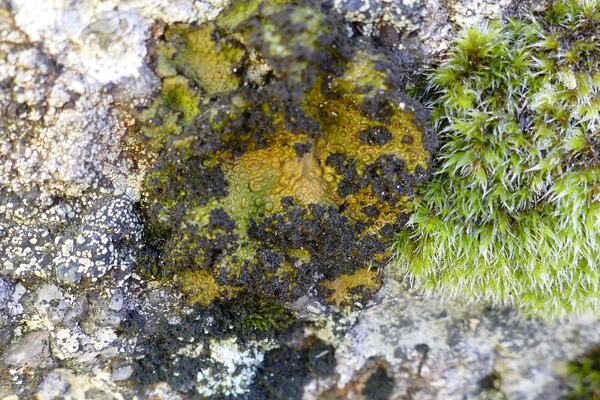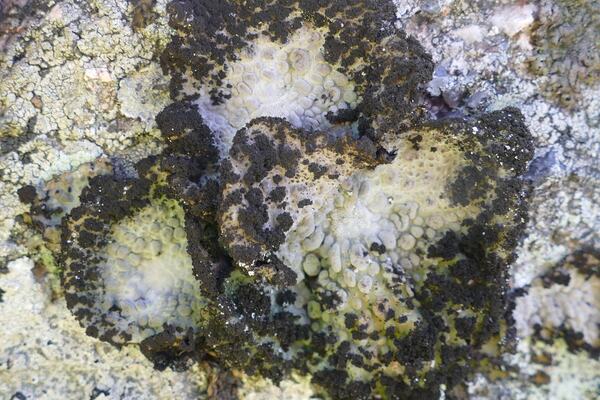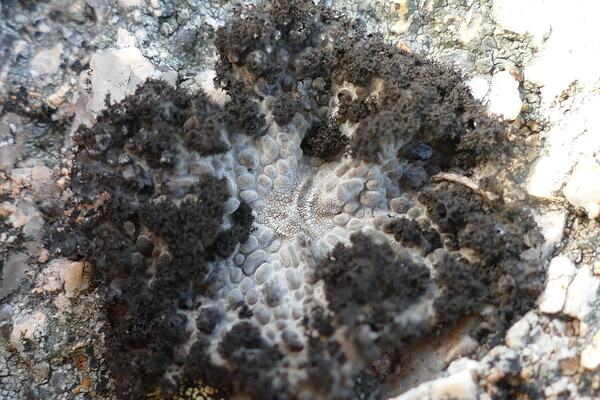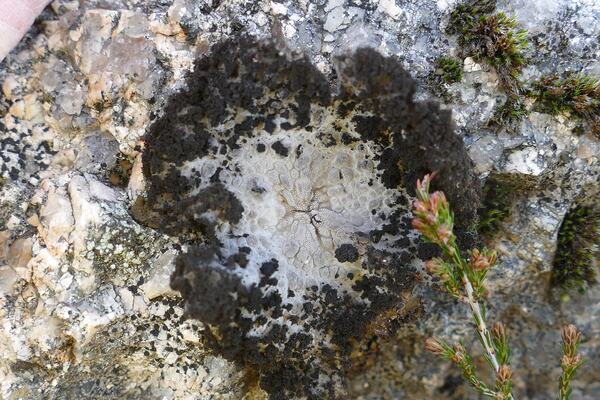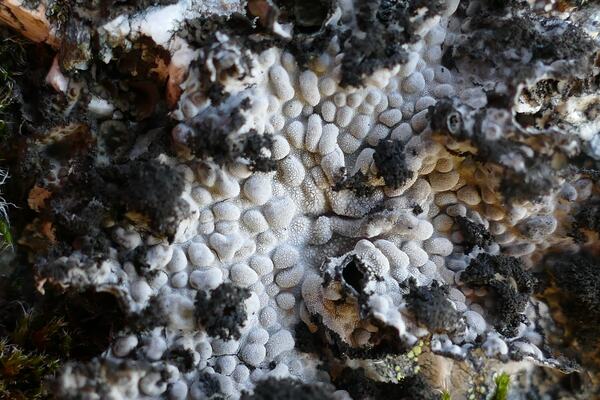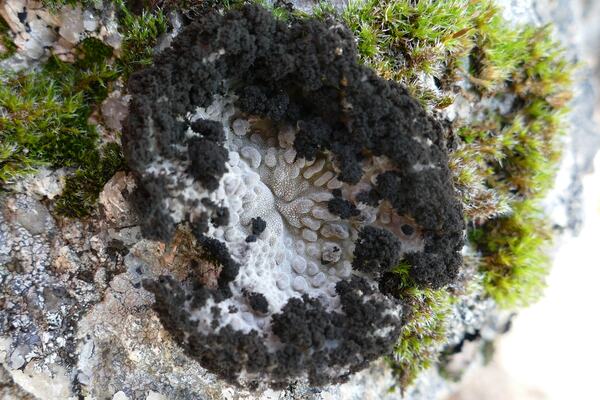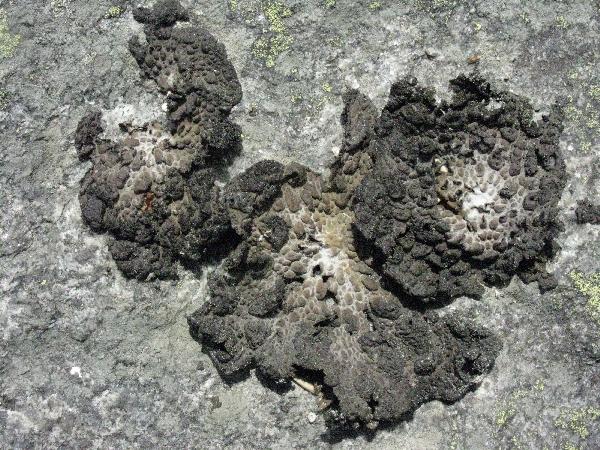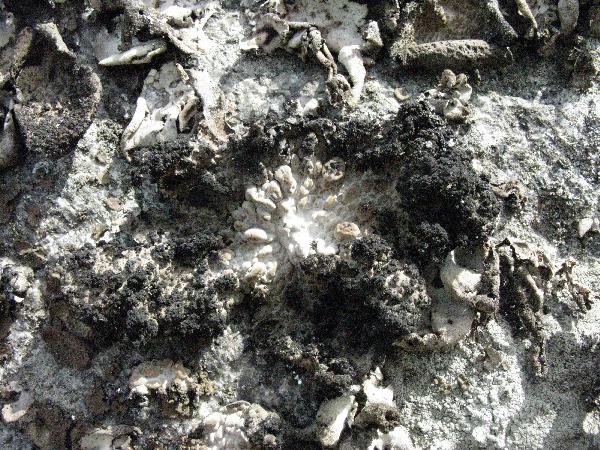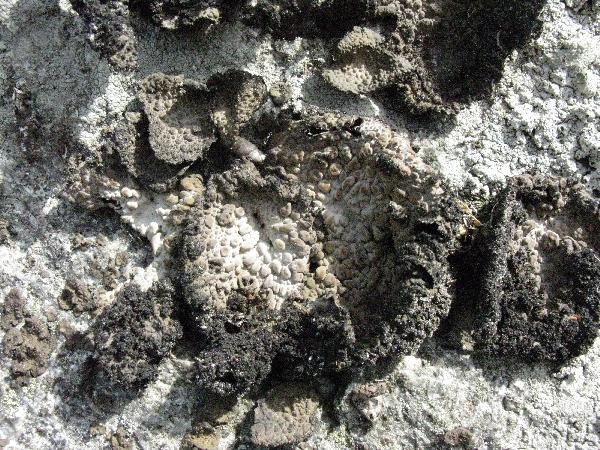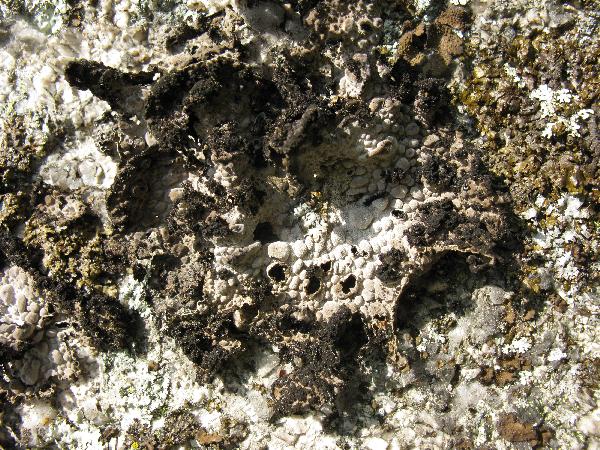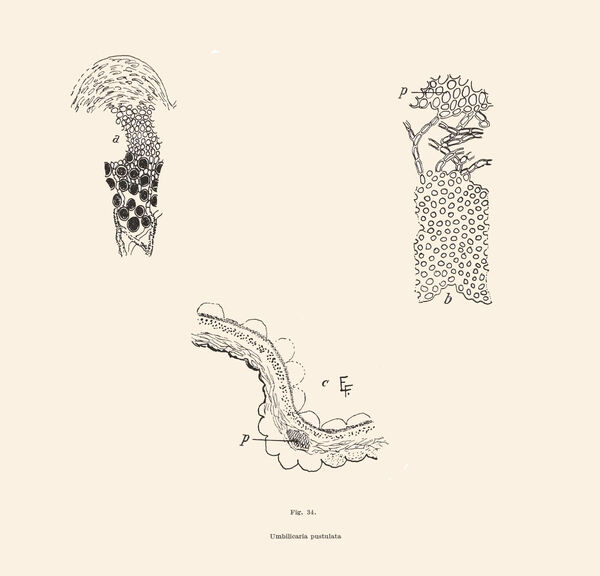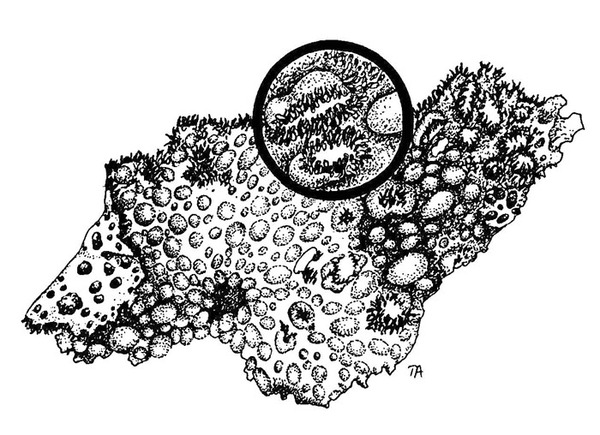Umbilicaria pustulata (L.) Hoffm.
Descr. Adumb. Plant. Lich. 2, 1: 13, 1791. Basionym: Lichen pustulatus L. - Sp. Pl.: 1150, 1753.
Synonyms: Gyrophora pustulata (L.) Ach.; Lasallia pustulata (L.) Mérat; Macrodictya pustulata (L.) A. Massal.; Umbilicaria pustulata (L.) Hoffm.
Distribution: N - Ven, TAA (Nascimbene 2006c), Lomb (Dalle Vedove & al. 2004), Piem (Morisi & Sereno 1995, Isocrono & Falletti 1999, Isocrono & al. 2003, Morisi 2005, Isocrono & Piervittori 2008), VA (Piervittori & Isocrono 1999), Emil (Fariselli & al. 2020), Lig (Brunialti & al. 1999). C - Tosc (Pišút 1997), Laz (Genovesi & al. 2011, 2011b), Sar (Monte 1993, Feige & Lumbsch 1994, Nöske 2000, Rizzi & al. 2011, Cossu & al. 2015, Neuwirth 2018). S - Camp, Bas (Potenza 2006,Lich. Ital. Exs. 57: Isocrono & al. 2021), Cal (Puntillo 1996), Si (Czeczuga & al. 1999, Ottonello 2005, Brackel 2008b).
Description: Thallus foliose-umbilicate, heteromerous, dorsiventral, monophyllous, usually large to very large, 3-10(-20) cm diam., dull brown but often coarsely white-pruinose when dry, green-brown when wet, attached by a stout, central holdfast. Upper surface with numerous conspicuous, convex, round to oval pustules, the margins becoming more or less eroded; isidia coralloid, dark, arranged in clusters, especially around cracks of the upper cortex. Lower surface grey to brown-black, reticulate, with broad depressions corresponding to the pustules, erhizinate; thalloconidia absent. Apothecia very rare, 1-3 mm across, with a black, flat, smooth disc and a persistent, smooth or partially isidiate true exciple. Epithecium black-brown; hymenium colourless, c. 100 µm high; paraphyses simple or sparingly branched, with enlarged apical cells; hypothecium dark brown, to 160 µm high. Asci 1(-2)-spored, elongate-clavate, thick-walled, with a K/I+ blue apical dome. Ascospores muriform, at fist hyaline, then brown, 28-70 x 18-34 μm. Pycnidia black, immersed, bottle-shaped, with a brown wall of isodiametric cells. Conidia bacilliform, 2.5-3 x c. 1 μm. Photobiont chlorococcoid. Spot tests: cortex K-, C-, KC-, P-; medulla K-, C+ red, KC+ red, P-, UV-. Chemistry: medulla with gyrophoric acid. Note: a temperate to boreal-montane, circumpolar species found on periodically wetted, but rapidly drying surfaces of basic siliceous rocks, usually in seepage tracks, with a wide altitudinal range, but usually absent above treeline. The species is widespread both in the Alps and in the mountains of Mediterranean Italy.
Growth form: Foliose, umbilicate
Substrata: rocks
Photobiont: green algae other than Trentepohlia
Reproductive strategy: mainly asexual, by isidia, or isidia-like structures (e.g. schizidia)
Commonnes-rarity: (info)
Alpine belt: absent
Subalpine belt: very rare
Oromediterranean belt: rare
Montane belt: rather rare
Submediterranean belt: very rare
Padanian area: absent
Humid submediterranean belt: very rare
Humid mediterranean belt: extremely rare
Dry mediterranean belt: absent
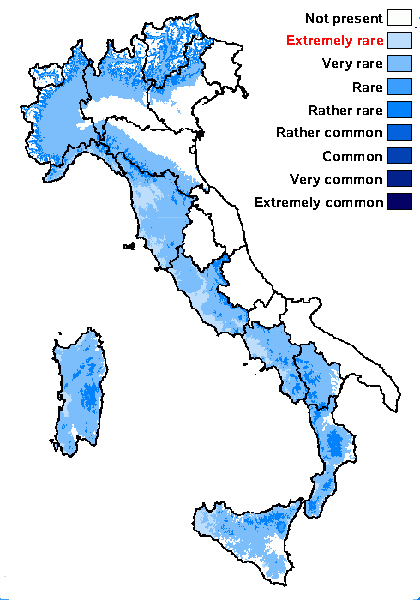
Predictive model
Herbarium samples
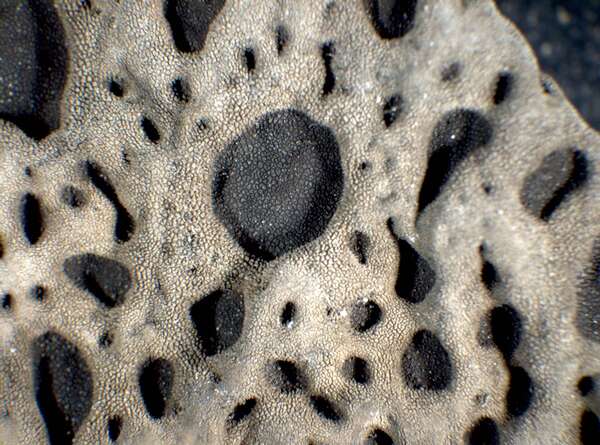

P.L. Nimis; Owner: Department of Life Sciences, University of Trieste
Herbarium: TSB (8260)
2001/11/25
detail of lower surface


P.L. Nimis; Owner: Department of Life Sciences, University of Trieste
Herbarium: TSB (8260)
2001/11/25
detail of isidia
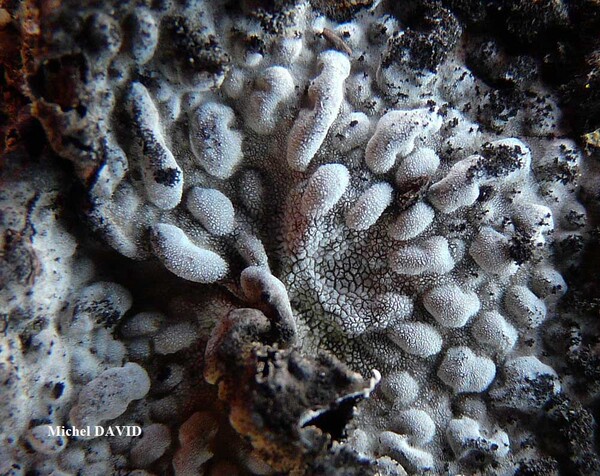
Michel David - Source: http://www.lichensmaritimes.org/index.php?task=fiche&lichen=126&lang=en
France, Postolonne
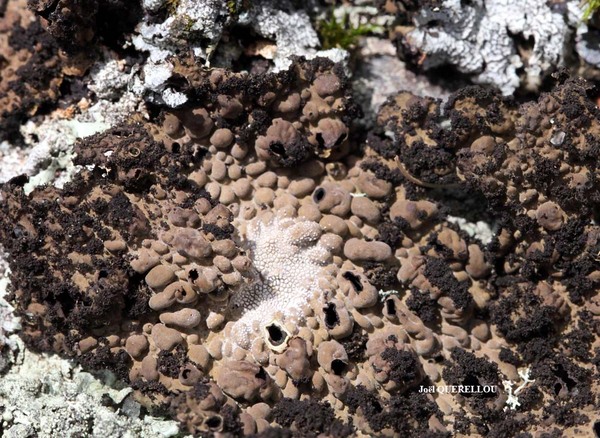
Joël Querellou - Source: http://www.lichensmaritimes.org/index.php?task=fiche&lichen=126&lang=en
France, Hanvec
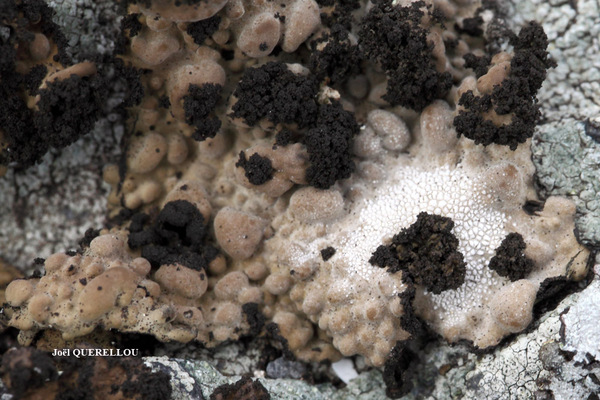
Joël Querellou - Source: http://www.lichensmaritimes.org/index.php?task=fiche&lichen=126&lang=en
France, Hanvec
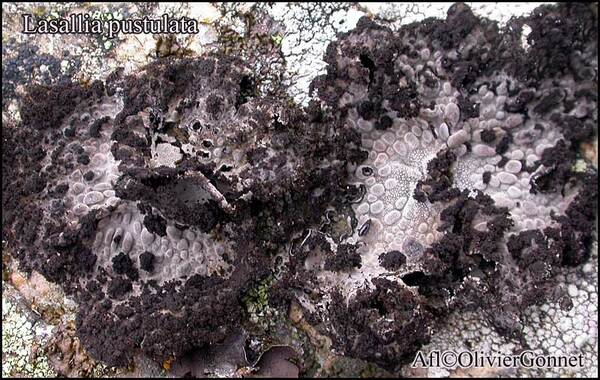
Courtesy Danièle et Olivier Gonnet - Source: https://www.afl-lichenologie.fr/Photos_AFL/Photos_AFL_U/Textes_U/Umbilicaria%20pustulata.htm
France, sur rocher siliceux - session AFL 2005 - Lozère
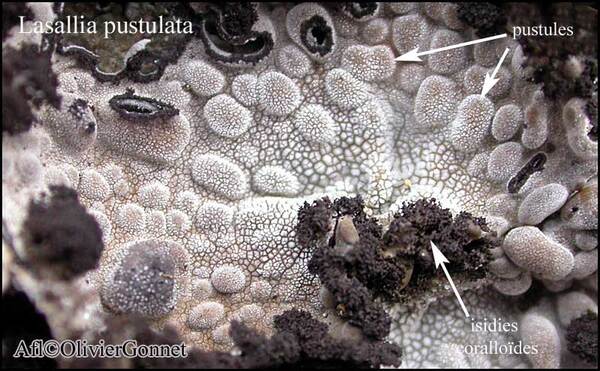
Courtesy Danièle et Olivier Gonnet - Source: https://www.afl-lichenologie.fr/Photos_AFL/Photos_AFL_U/Textes_U/Umbilicaria%20pustulata.htm
France, sur rocher siliceux - session AFL 2005 - Lozère

Bernard Bouffinier - Source: http://www.lichensmaritimes.org/index.php?task=fiche&lichen=126&lang=en
Italy, Sardinia
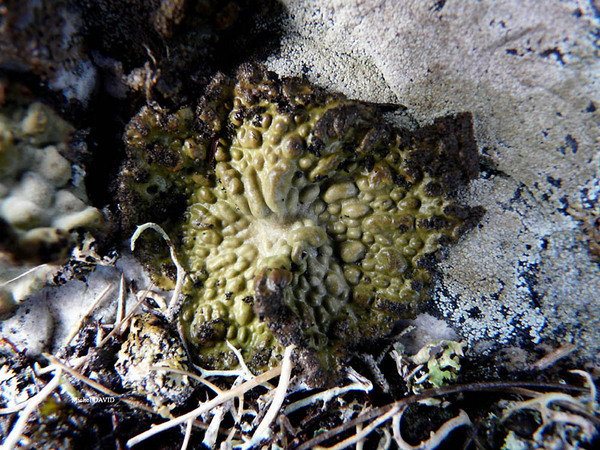
Michel David - Source: http://www.lichensmaritimes.org/index.php?task=fiche&lichen=126&lang=en
France, Tréberon
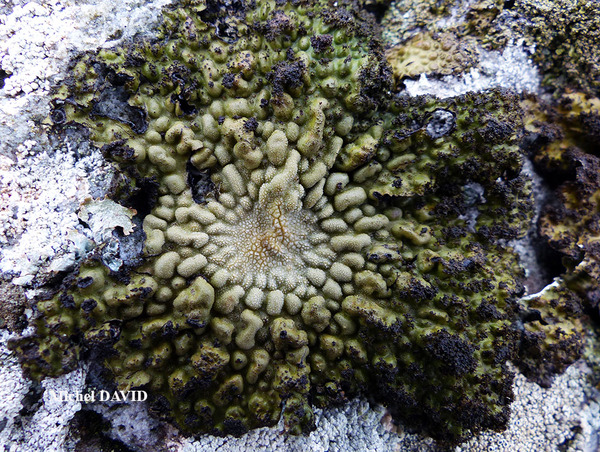
Michel David - Source: http://www.lichensmaritimes.org/index.php?task=fiche&lichen=126&lang=en
France, Tréberon
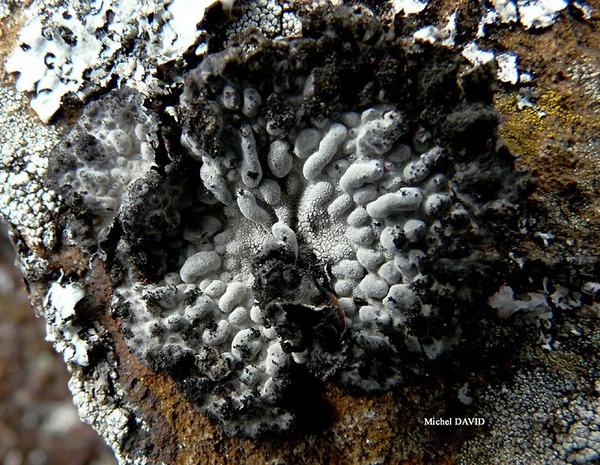
Michel David - Source: http://www.lichensmaritimes.org/index.php?task=fiche&lichen=126&lang=en
France, Tréberon
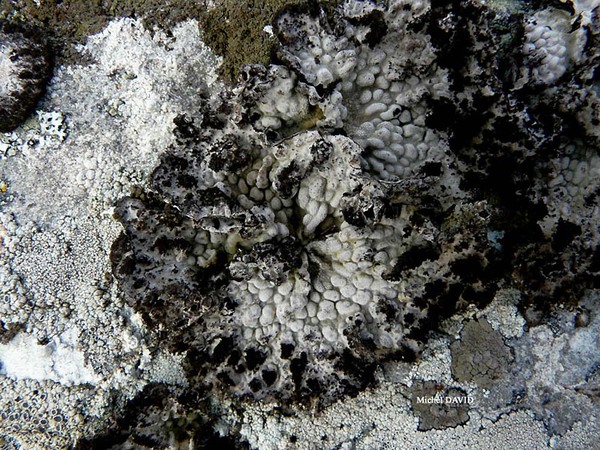
Michel David - Source: http://www.lichensmaritimes.org/index.php?task=fiche&lichen=126&lang=en
France, Tréberon

Michel David - Source: http://www.lichensmaritimes.org/index.php?task=fiche&lichen=126&lang=en
France, Hanvec
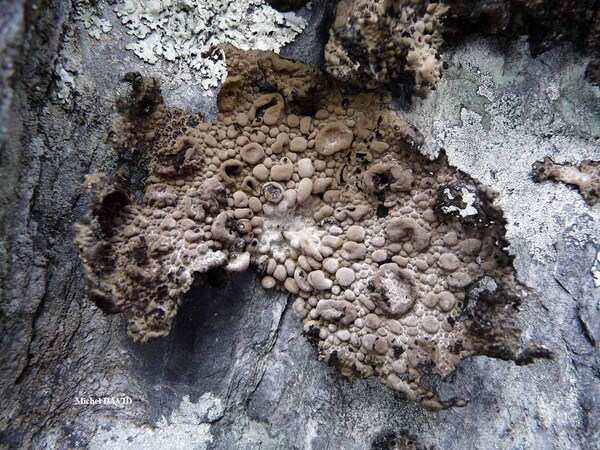
Michel David - Source: http://www.lichensmaritimes.org/index.php?task=fiche&lichen=126&lang=en
France, Hanvec
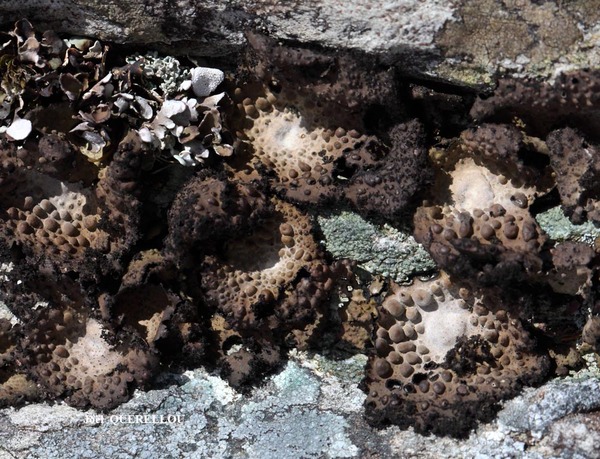
Joël Querellou - Source: http://www.lichensmaritimes.org/index.php?task=fiche&lichen=126&lang=en
France, Hanvec
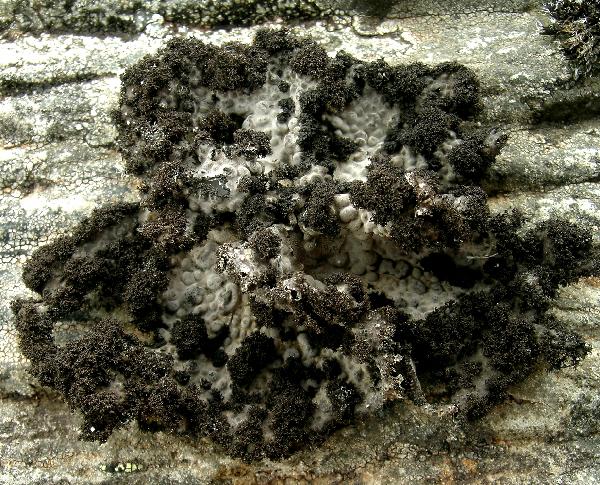
Ulrich Kirschbaum CC BY-SA 4.0 - Source: https://www.thm.de/lse/ulrich-kirschbaum/flechtenbilder
Portugal: Madeira.
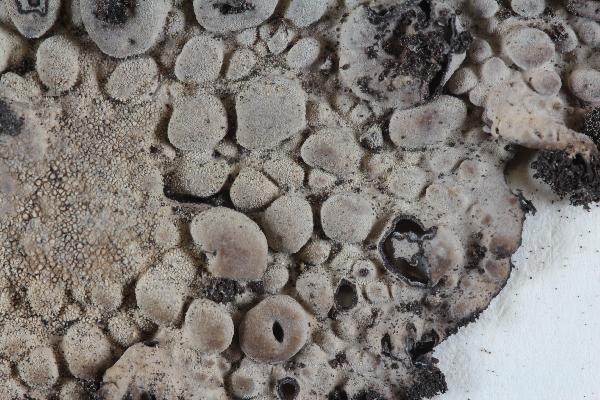
Collezione lichenologica Abramo Massalongo del Museo di Storia Naturale G. Ligabue di Venezia - Autori: Seggi, Linda; Trabucco, Raffaella Proprietà: Fondazione Musei Civici di Venezia - CC BY-NC
Italy, Veneto, in Euganeis (Pendice) (rarissima) 1855
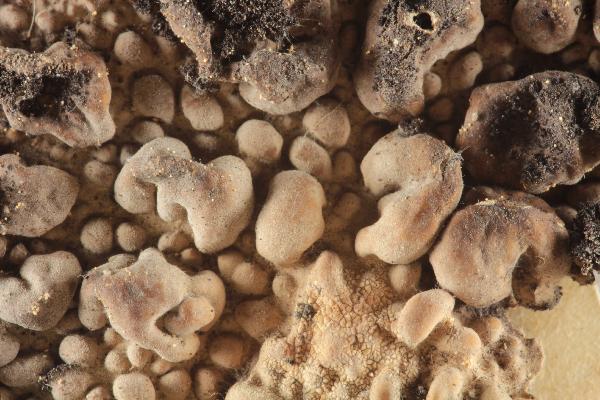
Collezione lichenologica Abramo Massalongo del Museo di Storia Naturale G. Ligabue di Venezia - Autori: Seggi, Linda; Trabucco, Raffaella Proprietà: Fondazione Musei Civici di Venezia - CC BY-NC
Ex herb. Friesii!
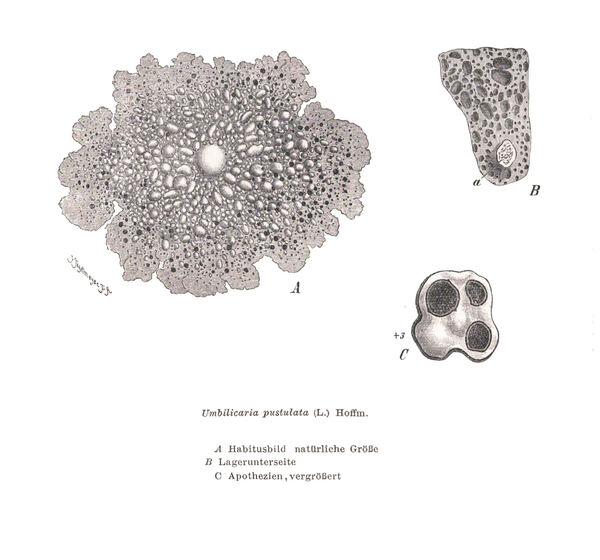
Zahlbruckner A. 1926. Lichenes (Flechten). In: Engler A. (ed.): Die natürlichen Pflanzenfamilien. 2nd ed., vol 8, W. Engelmann, Leipzig, 270 pp.
Growth form: Foliose, umbilicate
Substrata: rocks
Photobiont: green algae other than Trentepohlia
Reproductive strategy: mainly asexual, by isidia, or isidia-like structures (e.g. schizidia)
Commonnes-rarity: (info)
Alpine belt: absent
Subalpine belt: very rare
Oromediterranean belt: rare
Montane belt: rather rare
Submediterranean belt: very rare
Padanian area: absent
Humid submediterranean belt: very rare
Humid mediterranean belt: extremely rare
Dry mediterranean belt: absent

Predictive model
| Herbarium samples |


P.L. Nimis; Owner: Department of Life Sciences, University of Trieste
Herbarium: TSB (8260)
2001/11/25
detail of lower surface


P.L. Nimis; Owner: Department of Life Sciences, University of Trieste
Herbarium: TSB (8260)
2001/11/25
detail of isidia

Michel David - Source: http://www.lichensmaritimes.org/index.php?task=fiche&lichen=126&lang=en
France, Postolonne

Joël Querellou - Source: http://www.lichensmaritimes.org/index.php?task=fiche&lichen=126&lang=en
France, Hanvec

Joël Querellou - Source: http://www.lichensmaritimes.org/index.php?task=fiche&lichen=126&lang=en
France, Hanvec

Courtesy Danièle et Olivier Gonnet - Source: https://www.afl-lichenologie.fr/Photos_AFL/Photos_AFL_U/Textes_U/Umbilicaria%20pustulata.htm
France, sur rocher siliceux - session AFL 2005 - Lozère

Courtesy Danièle et Olivier Gonnet - Source: https://www.afl-lichenologie.fr/Photos_AFL/Photos_AFL_U/Textes_U/Umbilicaria%20pustulata.htm
France, sur rocher siliceux - session AFL 2005 - Lozère

Bernard Bouffinier - Source: http://www.lichensmaritimes.org/index.php?task=fiche&lichen=126&lang=en
Italy, Sardinia

Michel David - Source: http://www.lichensmaritimes.org/index.php?task=fiche&lichen=126&lang=en
France, Tréberon

Michel David - Source: http://www.lichensmaritimes.org/index.php?task=fiche&lichen=126&lang=en
France, Tréberon

Michel David - Source: http://www.lichensmaritimes.org/index.php?task=fiche&lichen=126&lang=en
France, Tréberon

Michel David - Source: http://www.lichensmaritimes.org/index.php?task=fiche&lichen=126&lang=en
France, Tréberon

Michel David - Source: http://www.lichensmaritimes.org/index.php?task=fiche&lichen=126&lang=en
France, Hanvec

Michel David - Source: http://www.lichensmaritimes.org/index.php?task=fiche&lichen=126&lang=en
France, Hanvec

Joël Querellou - Source: http://www.lichensmaritimes.org/index.php?task=fiche&lichen=126&lang=en
France, Hanvec

Ulrich Kirschbaum CC BY-SA 4.0 - Source: https://www.thm.de/lse/ulrich-kirschbaum/flechtenbilder
Portugal: Madeira.

Collezione lichenologica Abramo Massalongo del Museo di Storia Naturale G. Ligabue di Venezia - Autori: Seggi, Linda; Trabucco, Raffaella Proprietà: Fondazione Musei Civici di Venezia - CC BY-NC
Italy, Veneto, in Euganeis (Pendice) (rarissima) 1855

Collezione lichenologica Abramo Massalongo del Museo di Storia Naturale G. Ligabue di Venezia - Autori: Seggi, Linda; Trabucco, Raffaella Proprietà: Fondazione Musei Civici di Venezia - CC BY-NC
Ex herb. Friesii!

 INDEX FUNGORUM
INDEX FUNGORUM
 GBIF
GBIF
 DOLICHENS
DOLICHENS
